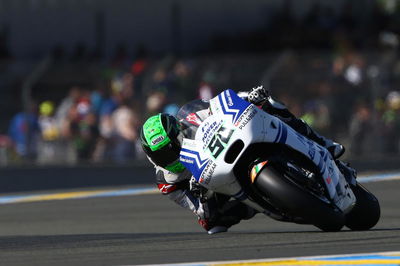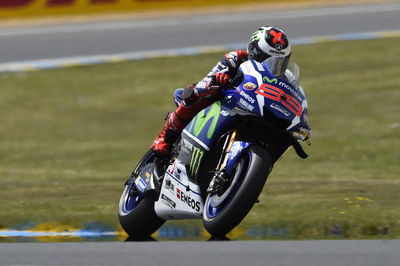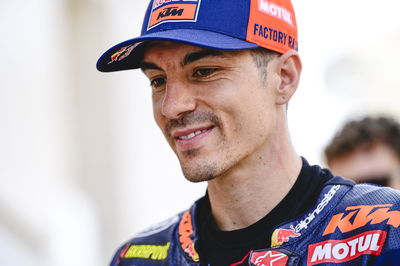Michael Laverty: Eugene has made a huge step

This time last season, Eugene Laverty was languishing down in 21st place in the MotoGP standings, having scored just two points.
But the Irishman heads for this weekend's Mugello round a strong ninth in the world championship - as the second best Ducati rider - after pulling in 33 points and a best race finish of fourth.
So how did it happen?
Crash.net asked Eugene's older brother, former MotoGP racer and current BSB title contender Michael Laverty, to explain...
"Eugene has made a huge step compared with last year," began Michael, speaking at the Sepang World Superbike round, where he was assisting brother-in-law Chaz Davies.
"There's a lot to learn when you go to MotoGP with the advanced electronics, the tyres and just how the whole thing kind of clicks and gels together. So having a year's worth of experience at each circuit and how a grand prix bike works was always going to be a benefit.
"But he didn't really get to capitalise on that over the winter because injuries ruled him out of most of pre-season testing, when he also had a completely new bike to learn with the Ducati. But once he arrived for round one in Qatar, where he got the latest spec engine for the 14.2 and was just getting over his injuries - he still wasn't 100% - that was when 'testing' really started.
"Eugene's steadily improved since then. He really likes the package Ducati have given him. He feels the engine, electronics and chassis are all an improvement over last year [on the Open class Honda]. He's got to grips with it pretty quickly, given that he missed pre-season in the grand scheme of things.
"Eugene is not someone who just relies on natural ability. He's almost like a computer. He rides on facts and figures - feeling as well - but he likes to figure it all out. He's very methodical in his process. I personally ride a bit more on feel. He likes to document everything.
"Now that he's really figured it out, he'll go from strength-to-strength. He's ninth in the world championship and been really consistent this year. Every race he's been in the points and regularly challenging for the top ten. Had it not been for the technical problem at Le Mans he would have been on for another seventh place or so. He's knocking on the door of the top private teams and edge of the factory teams.
"So doing a great job and kind of what I expected of him. Last year was way tougher than I expected, because I know he's a quality rider. But just having better machinery and a new crew chief; Phil Marron, who has worked with him in World Supersport and World Superbikes. They moved Phil in this year and that's made a big difference. Having that support network, relationship and rapport - Phil knows what Eugene is thinking before he says it. It just works that way if you've got a crew chief you really trust.
"The team also get good technical support from Ducati. Gigi Dall'Igna is in the garage after every session and it's an 'open chain' for all the Ducatis. So Eugene can look at Iannone's data and Dovi's data - they all learn a bit from each other. The Ducati programme works well and I think having that free flow of information has really suited Eugene because of the way he works on the facts and figures. He really likes the details of it all, so it's been a big advantage to him.
"Eugene will continue to grow due to his nature and methodical way of going racing. The more they throw at him and the more technical improvements they give him, the more he will excel. I hope he gets that opportunity next year with another step-up in machinery. That would be great and I think he can definitely cut the mustard."
Crash.net:
How would you describe Eugene's riding style?
Michael Laverty:
"One of the things he does better than I can ever do is he gets the bike picked up really well off the corner. That's a very strong string to his bow. He can brake as late as me and turn-in the same, but the extra bit that he does - and he could do it a lot in World Superbike - is just getting the bike turned and squared up onto the fat part of the tyre to get good drive.
"That's one of his biggest strengths and it's a tough thing to do, especially if a bike is not working for you. Last year he didn't look at home on the Honda, but he could still get it off the turn really well. He's a good all-around rider. There's no apparent weakness when I watch him. He's good on braking, corner speed and corner entry and, like I say, the acceleration he gets is very strong.
"I think during the years in World Superbike with Pirelli tyres he adapted his style, because that really worked for him here [in WSBK]. Then when he went to Bridgestones in MotoGP last year I think he was in that riding style and possibly didn't take enough out of the Bridgestone tyre, because there was extra side grip and he stayed on that 'picking the bike-up' technique for too long.
"Now he's adapted to get the best of both worlds; he's learned to use that extra edge grip - also with the Michelins this year - and carries more on the side of the tyre, but still gets the bike up on the fat part for corner exit. Overall he's a very complete package as a rider. He has good race craft. We've seen him win lots of last lap scraps, he's very good when it comes to figuring a race out and adjusting his strategy as it goes. Although he never won the World Supersport championship, I think in the two years he led the most laps, so he can also keep his head when running in front."
Crash.net:
You helped to develop the Michelin MotoGP tyres while testing for Aprilia last season, how do you think the riders are adapting?
Michael Laverty:
"The Michelins are very different to the Bridgestones that have been in the bikes for years and all the bikes have been developed towards that front-end riding style. With a lot of load in the front tyre. It's just taken a while for everyone to re-calibrate the bike setting and riding style.
"Le Mans was the first time I'd been trackside this year and Marc Marquez is a prime example, because on the Bridgestone's he was so loose and aggressive, pushed the front tyre so hard. Okay, he's still loose and ragged compared with the majority of guys, but he looks smooth compared with the old Marc.
"So he's had to settle down because you just can't put that extreme load into the front tyre. You could with the Bridgestone. So he's adapted his riding style and machine set-up to use the Michelin front.
"The Michelin is a good tyre, it's just very different to what everyone has been used to and the way they had the set-up, to exploit the strength of the Bridgestone front. The Bridgestone took an extreme amount of load and lean angle. You can brake upright as hard on both tyres; it was just when you approached the turn with the Bridgestone; the harder you pushed it the better the feedback was.
"It was mind boggling how much load you could put in! You could trail the front brake all the way to the apex and keep scrubbing speed all the way in, and when you did that the Bridgestone tyre worked better and gave you feedback. I've never known another tyre that you could do that on.
"So when you change tyres and remove that element, and the bikes are set-up to go fast by riding that style, then you're going to have problems. When the tyre can no longer cope with that load mid-corner. That's been the biggest thing and it's why so many riders have been crashing.
"But Michelin have improved their front to get closer to the Bridgestone character and now the bike set-ups are changing. The lap times are still there, but done in a different way. The Michelins are performing every bit as fast, just two different ways of doing it. I did say that at the end of last year; I felt the Michelins were good, they were just different.
"There were a lot of crashes when the Michelins were introduced, but I don't think it was a lack of performance on their part, just the different character catching everyone out. I think Michelin actually had a better rear performance than the Bridgestone and now they've had to bring the rear performance back a bit. They've gone for a harder carcass that creates more spin and that's probably assisted the front tyre as well, because having so much grip from the rear pushes the front tyre. So earlier in the year with that really grippy rear, you had even more load on the front.
"They've found a better balance in the last few rounds. When you speak to all the riders they are a lot happier with them. I guess it's been a six-month transition period but it now seems to be almost over - although people are getting caught out in the races with them a lot. You didn't see as many fallers in the Bridgestone era. So although the crashes have stopped on the one-off laps, there is still something to find over race distance."
Crash.net:
What do you think about Bradley Smith's theory, that maybe the front tyre pressure is rising a little in the races and changing the behaviour of the tyre?
Michael Laverty:
"I read Bradley's theory and that can happen sometimes; the pressure can creep up and then the tyre is not as compliant when you hit a bump. It's very possible. I haven't ridden the latest generation of Michelins so I'm not qualified to answer 100%, but I would give Bradley's opinion a lot of credibility. I think there's a big possibility that could be the case."












